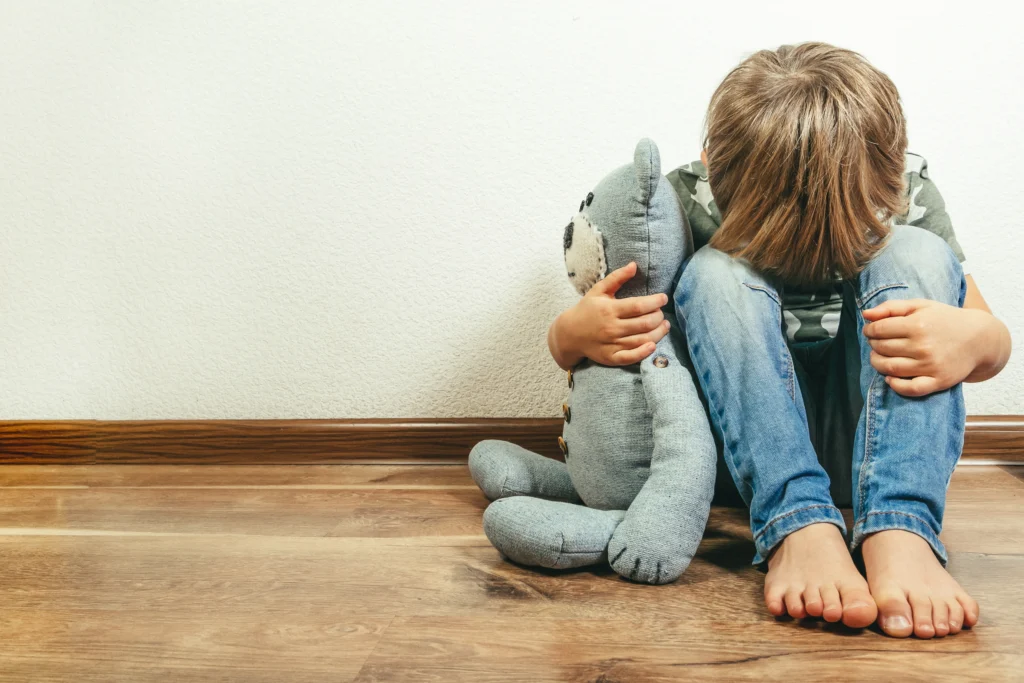Childhood trauma is one of the main problems many children have to face when born into a world of abuse, neglect, and household dysfunction.
The effects of such trauma can manifest in various ways, triggering a host of symptoms.
Understanding what causes and impacts childhood trauma can have on a child can make a world of difference in caring for an affected child.
With the right approach, you can offer meaningful support that helps the child navigate their feelings to improve their mental and physical health.
What is Childhood Trauma?
Childhood trauma refers to deeply distressing experiences that surpass a child’s ability to cope and adapt, leaving lasting effects on their mental, emotional, and physical well-being.1
This type of trauma can stem from various causes, including abuse, neglect, witnessing violence, or adverse household environments.
Unlike typical stress, which is temporary and manageable, trauma embeds itself, often influencing a child’s development and resilience long-term.
Common Causes of Childhood Trauma
Childhood trauma can arise from a range of distressing experiences that disrupt a child’s sense of safety and well-being.
Common causes include:
- Physical Abuse: Harmful physical actions, such as hitting, kicking, or other forms of violence directed at the child.2
- Emotional Abuse: Verbal or psychological mistreatment, including belittling, shaming, or manipulating.
- Sexual Abuse: Inappropriate sexual behavior or contact with a child.
- Neglect: Failure to provide basic needs, such as food, shelter, medical care, or emotional support.3
- Witnessing Domestic Violence: Exposure to violence between caregivers or family members in the home.
- Substance Abuse in the Household: Living with a family member struggling with addiction or substance misuse.
- Mental Illness in the Family: Growing up with a caregiver who has untreated mental health issues.
- Loss of a Loved One: Experiencing the death of a close family member or loved one at an early age.
- Divorce or Separation: High-conflict separations that create an unstable or tense home environment.
- Natural Disasters: Experiencing events like hurricanes, floods, or fires disrupt a child’s sense of safety and security.
Discover Specialized Trauma Support at Cornerstone
Explore residential, outpatient, and virtual pathways to mental health recovery in Arizona.

Effects and Impact of Childhood Trauma
Childhood trauma can lead to both immediate and long-term effects on a child’s mental, emotional, and physical health.
Immediate Effects
In the short term, trauma often manifests in behaviors and symptoms that disrupt a child’s daily life, affecting their social interactions, academic performance, and overall well-being.
- Anxiety and Fear: Trauma can cause heightened worry or feelings of insecurity, making it difficult for children to feel safe.
- Aggression: Irritability and anger are common, sometimes leading to disruptive or oppositional behavior.
- Emotional Withdrawal: Many children withdraw from social interactions, feeling isolated or misunderstood.
- Sleep Disturbances: Trouble falling or staying asleep due to lingering stress or fear.
- Difficulty Concentrating: Challenges with focus, which can lead to struggles in school and lower academic performance.
Long-Term Effects
Long-term childhood trauma can leave deep emotional scars that affect a child well into adulthood.
Issues such as relationship difficulties, mental health struggles, and even chronic physical health conditions can develop as a result of unresolved trauma.
- Difficulty Forming Relationships: Trauma can make it harder to trust others, impacting the ability to form close bonds.
- Mental Health Challenges: Increased risks of depression, anxiety, and other mood disorders often arise from untreated trauma.
- Chronic Health Issues: Trauma is linked to physical health problems like heart disease and weakened immune function.
- Risky Behaviors: Increased likelihood of substance misuse, self-harm, or other harmful coping mechanisms.
Early intervention is essential to minimize these effects, helping children develop resilience and offering them a supportive path toward healing.
Recognizing Symptoms of Childhood Trauma
Recognizing trauma in children is essential for early intervention and support.
Symptoms can present in various ways, including behavioral, emotional, and physical signs, each of which can indicate that a child may be struggling with past distressing experiences.
By identifying these symptoms early, parents, caregivers, and teachers can offer the necessary support to help children navigate their emotions and begin the healing process.
Behavioral Indicators
Behavioral changes are often the first signs of trauma in children, as they may express their feelings through actions rather than words. Common behavioral indicators include:
- Aggressive Behavior: Increased irritability, anger outbursts, or even physical aggression toward others.
- Social Withdrawal: Avoidance of friends, family, or activities they once enjoyed, and a preference for isolation.
- Unusual Attachment: Clinging to certain people or objects for a sense of security, often as a response to feeling unsafe.
- Regressive Behaviors: Returning to earlier behaviors, such as thumb-sucking, bedwetting, or needing excessive reassurance.
- Hypervigilance: Being excessively alert or easily startled, as if constantly on guard.
Emotional Symptoms
Emotionally, trauma can manifest through intense feelings that may be overwhelming for a child to process alone. Emotional symptoms often include:
- Anxiety: Persistent worry, nervousness, or a heightened sense of fear, especially in unfamiliar situations.
- Depression: Signs of sadness, low energy, loss of interest in daily activities, or a sense of hopelessness.
- PTSD Symptoms: Experiencing flashbacks, nightmares, or intrusive memories, coupled with efforts to avoid reminders of the traumatic event.
Quick Tip: Creating a Safe and Supportive Space for Your Child
If your child shows signs of trauma, support them by building a trusting and secure home environment where your child feels free to express their emotions. Create an open line of communication, ensuring they know you’re always there to help if they need it and can help them find professional assistance if that’s more comfortable for them.
Trauma Therapy and Recovery Options
Healing from childhood trauma often requires a multi-faceted approach, combining therapeutic techniques and a supportive environment to foster resilience.
Professional therapy is a foundational step in the recovery journey, providing a safe space for individuals to process their experiences and learn effective coping strategies.
Tailoring therapy to each person’s needs, alongside strong support networks, plays a crucial role in overcoming the effects of early trauma.
Types of Therapy
Several therapeutic approaches are highly effective in addressing childhood trauma and supporting long-term healing:
- Cognitive Behavioral Therapy (CBT): This method helps individuals identify and reframe negative thought patterns associated with past trauma, promoting healthier emotional responses and resilience.
- Trauma-Focused Therapy: Specialized for trauma recovery, this approach addresses specific traumatic experiences, guiding individuals through safe, structured processes to reduce the emotional impact.
- EMDR (Eye Movement Desensitization and Reprocessing): EMDR is often used for trauma recovery, helping individuals process traumatic memories and lessen their emotional intensity.
- Group Therapy: Sharing experiences with others who have faced similar challenges can provide a sense of connection and reduce feelings of isolation, building a community of support.
Each therapy offers tools and techniques to help individuals process and integrate traumatic memories, making them more manageable and less disruptive to daily life.
Role of Support Systems
A strong support network is essential to overcoming childhood trauma, providing stability, empathy, and understanding.
Family members, friends, and community resources all contribute to creating a safe, nurturing environment that reassures individuals they are not alone.
Family members can support recovery by fostering open communication, practicing empathy, and encouraging healthy coping methods.
Community resources, such as support groups and trauma-focused programs, offer additional avenues for guidance, helping individuals build resilience and confidence throughout their healing journey.
By combining therapy with a supportive environment, individuals can work through their experiences constructively, empowering them to reclaim a sense of control and well-being in their lives.
Frequently Asked Questions
What are the common signs of childhood trauma?
Common signs include behavioral changes like aggression or withdrawal, emotional outbursts, anxiety, and sleep disturbances. Recognizing these early indicators allows caregivers to provide appropriate support and seek necessary interventions for children in need.
How can parents support a child who has experienced trauma?
Parents can help by creating a stable, loving environment, fostering open communication, and seeking professional support if needed. A safe space where children feel comfortable expressing their feelings is crucial for healing.
What therapies are effective for childhood trauma?
Cognitive Behavioral Therapy (CBT), play therapy, and family counseling are all effective options for childhood trauma. These therapies equip children with coping tools and support them in processing their experiences healthily.
Key Takeaways
- Key Takeaways
- Understanding the behavioral, emotional, and physical signs of trauma in children is essential for timely support and intervention.
- Professional therapy, such as CBT, trauma-focused therapy, EMDR, and play therapy, provides children with safe spaces to process their emotions and develop healthy coping skills.
- A strong support system, including family, friends, and community resources, is vital in helping children feel secure, fostering resilience as they recover.
- Unresolved childhood trauma can lead to lasting emotional and physical health challenges. Continued support and therapeutic guidance are essential for promoting lasting recovery and well-being.
- Everyone's journey is unique, and individualized therapy plans and supportive environments are key to effective, long-term healing.
Finding Hope and Healing Through Trauma Recovery
Recognizing and addressing trauma is vital to fostering resilience and long-term well-being for anyone affected.
Early intervention and support create a safe space to process experiences and build healthy coping strategies.
Whether you’re supporting a child, friend, or family member, seeking professional guidance can make a profound difference.
Cornerstone Healing Center offers trauma-focused treatment and compassionate care to guide individuals and families through the recovery process, helping them find stability and hope for the future.





